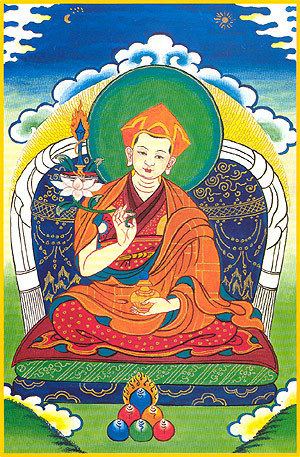Name Pema 1st | Died 1697 | |
 | ||
Dzogchen Pema Rigdzin (Tibetan: རྫོགས་ཆེན་པདམ་རིག་འཛིན, Wylie: rdzogs chen padma rig 'dzin) (1625–1697) was the 1st Dzogchen Rinpoche of Tibet and a disciple of the Fifth Dalai Lama. Pema Rigdzin was a mindstream 'emanation (Sanskrit: nirmanakaya) of Vimalamitra, Padmasambhava and Saraha.
Contents
Nomenclature and etymology
'Pema' is a Tibetan contraction or dialectic variant of 'lotus' (Sanskrit: padma) and Rigdzin (Tibetan; Sanskrit: vidya-dhara) may be rendered into English as "awareness holder" or "container of rigpa".
Exegesis
In 1684, at the age of 61 years, he stumbled upon the hidden location of Rudam, a sacred valley at which Guru Padmasambhava visited and blessed with his presence. In coordination with his three main disciples, there in the valley he established the monastery of Dzogchen Rudam Orgyen Samten Chöling, known as the Dzogchen Monastery which today lies in Sichuan province in China.
Iconography
In the icongraphic representation of Pema Rigdzin herewith, within his right or upaya-hand he holds the stem of a lotus (Sanskrit: padma (attribute) sprouting from his heartmind chakra (Tibetan: khorlo) that functions as a dais for the Dharma, represented by a book or tomb, which in turn supports the flaming sword of prajna (Sanskrit) often seen as an attribute of Manjushri. Iconographically, flames denote 'spiritual power' in the Himalayan thangka twilight language tradition. In the sky above his head reside the Sun and Moon in balance, metonymic of the solar and lunar subtle channels of the subtle body. The Sun and Moon and clouds also form a simulacrum of the 'Face of Glory' (Sanskrit: kirtimukha). The triratna is represented by the stylized trefoil pattern upon the foundation of the throne that supports him. The colored objects in the foreground are 'wish-fulfilling jewels' (Sanskrit: cintamani). In his left or prajna-hand at the level of the Muladhara (or one of the other three foundation khorlo) is the 'Urn of Wisdom' (Sanskrit: bumpa) which is one of the Ashtamangala. The foundation of wisdom is an awareness of the 'base' (Tibetan: གཞ, Wylie: gzhi), a very important theological concept and locus of practice in traditions of Dzogchen. The Bumpa is also evident as his aureole. The clouds are represent of the sky or aether.
